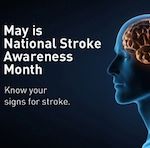National Stroke Awareness Month 2011
May is National Stroke Awareness Month, which focuses on raising public awareness about stroke.
Every "40 seconds someone has a stroke. On average, every 4 minutes someone dies of a stroke" - The American Stroke Association

May is National Stroke Awareness Month during which the American Stroke Association (ASA) works to raise public awareness and education about stroke. With approximately 795,000 strokes occurring each year, it is important that health care professionals educate their patients on the warning signs:
- Sudden numbness or weakness of the face, arm or leg, especially on one side of the body
- Sudden confusion, trouble speaking or understanding
- Sudden trouble seeing in one or both eyes
- Sudden trouble walking, dizziness, loss of balance or coordination
- Suddent, severe headache with no known cause
In a recent ASA survey, the results showed that "nine out of 10 Americans between the ages of 18-24 believe they're living healthly lifestyles - yet most are not, which increases their risk of a future stroke."
Education
In 2008, MDNG spoke with Olajide Williams, MD, MS, director of the Harlem Stroke Intitiative for Children, during which he discussed his involvement with the Hip Hop Stroke Program that was conceived by the National Stroke Association in 2005. The goal was to educate children about stroke. During the interview, Williams said, "Traditionally, adults educate children, but with Hip Hop Stroke, we're trying to have the children educate adults by taking the message home."
Programs like Dr. Williams are so important for any medial problems, and demonstrates the need to educate people of all ages.
Here are links to patient education resources about stroke on the American Stroke Association's website:
Emergency physicians, neurologists, hospitalists and nurses can take the National Institutes of Health stroke scale training and testing, and earn continuing education credit.
Get With The Guidelines--Stroke
GWTG—Stroke helps ensure continuous quality improvement of acute stroke treatment and ischemic stroke prevention. It focuses on care team protocols to ensure that patients are treated and discharged appropriately.
One minute of brain ischemia can kill 2 million nerve cells and 14 billion synapses. That means the more time that elapses before intravenous thrombolysis, the slimmer the odds of a good outcome. The upside is a great opportunity to improve outcomes simply by providing the right treatment, right away. Target: Stroke was created to help you seize that opportunity by achieving door-to-needle (DTN) times of 60 minutes or less.
Resources you can order or download to enrich your patients' knowledge of their condition and recovery.
Management of Stroke in Infants and Children
In its first scientific statement on stroke in infants and children, the American Heart Association/American Stroke Association addresses treatments, symptoms and risks.
Stroke Learning Library -- Statements, guidelines and more
Find clinical updates, commentaries, statements, guidelines and much more at My AmericanHeart for Professionals.
The mission of the Stroke Council is to foster excellence in stroke research and education and to achieve the objectives of the American Stroke Association in research, treatment and prevention.